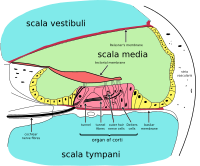
Photo from wikipedia
Minimally traumatic surgical techniques and advances in cochlear implant (CI) electrode array designs have allowed acoustic hearing present in a CI candidate prior to surgery to be preserved post-operatively. As… Click to show full abstract
Minimally traumatic surgical techniques and advances in cochlear implant (CI) electrode array designs have allowed acoustic hearing present in a CI candidate prior to surgery to be preserved post-operatively. As a result, these patients benefit from combined electric-acoustic stimulation (EAS) post-operatively. However, 30-40% of EAS CI users experience a partial loss of hearing up to 30 dB after surgery. In the present study, electrocochleography (ECoG) was used to study cochlear microphonic (hair cell response) and auditory nerve neurophonic (neural response) in patients with preserved hearing and patients with loss of hearing. These measures were obtained longitudinally over the course of CI use. At each test session, ECoG amplitude growth functions for several low-frequency stimuli were obtained. The threshold, slope, and suprathreshold amplitude at a fixed stimulation level was obtained from each growth function at each time point. Subjects were categorized as having stable hearing or loss of hearing. Longitudinal linear mixed effects models were used study trends in ECoG thresholds, slopes, and amplitudes for these two categories of subjects. Results showed that CM and ANN thresholds and amplitudes were stable in CI users with preserved residual hearing. CM and ANN thresholds increased (worsened) while CM and ANN amplitudes decreased (worsened) for those with delayed hearing loss. The slope did not distinguish between subjects with stable hearing and subjects with delayed loss of hearing. These results provide a new application of post-operative ECoG as an objective tool to monitor residual hearing and understand the pathophysiology of delayed hearing loss.
Journal Title: Ear and hearing
Year Published: 2022
Link to full text (if available)
Share on Social Media: Sign Up to like & get
recommendations!